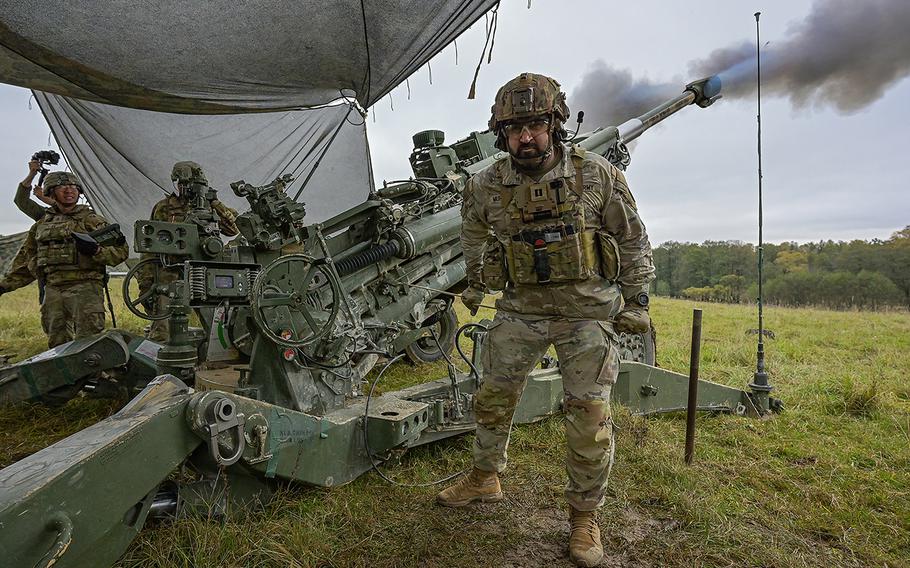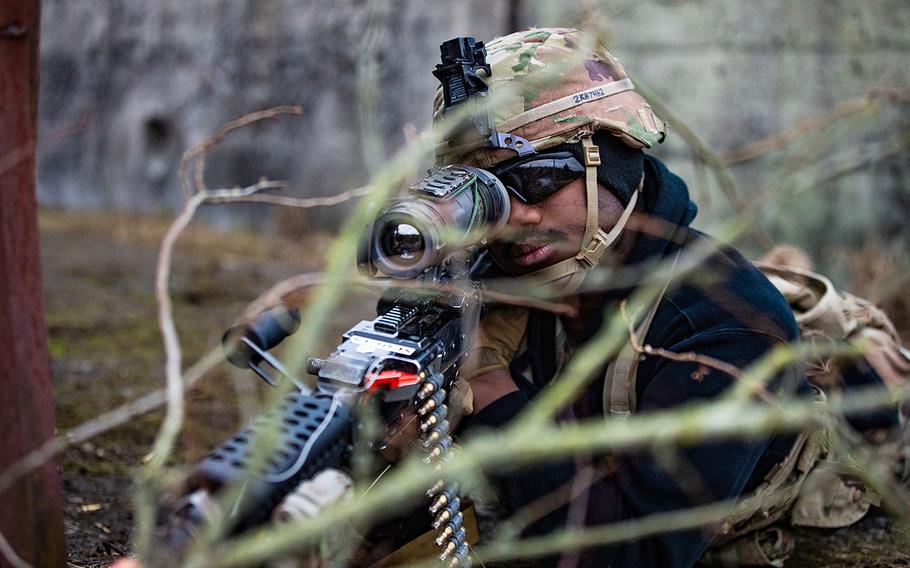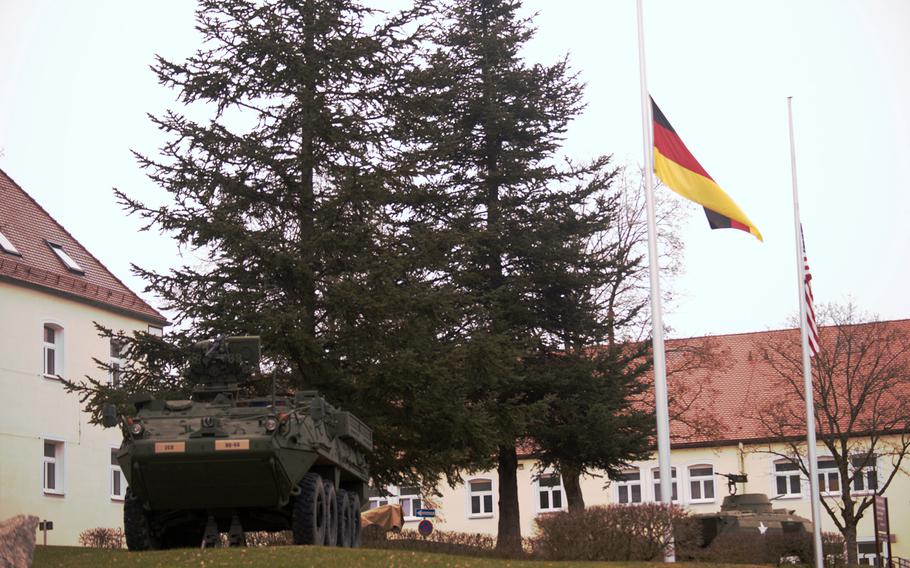
Capt. Raza Muhammad, assigned to Field Artillery Squadron, 2nd Cavalry Regiment, pulls the lanyard to fire a M777 howitzer during an exercise at Grafenwoehr Training Area, Germany, Oct. 18, 2024. (Markus Rauchenberger/U.S. Army)
GRAFENWOEHR, Germany — President-elect Donald Trump’s imminent return to the Oval Office is reviving concerns about a Vilseck-based Army brigade’s future in Germany.
The 2nd Cavalry Regiment was among the 12,000 troops designated for withdrawal under an eleventh-hour plan from Trump’s first administration that President Joe Biden scrapped before it could be enacted.
Army leaders have called the regiment the “go-to brigade for quick response” within U.S. European Command, and its role on the Continent has been magnified by Russia’s full-scale invasion of Ukraine. The regiment also leads NATO’s multinational battle group in Poland.

Army Pvt. Kendrick Harper, assigned to the 2nd Cavalry Regiment, searches for enemies during a training exercise in Vilseck, Germany, on Feb. 6, 2024. The regiment is one of NATO’s top ground combat options if the need arises for a quick response to a crisis in Europe. (William Kuang/U.S. Army)
Trump hasn’t said anything publicly about moving troops out of Germany since winning the November election. However, he has called on allies to spend a lot more on defense.
In a Dec. 8 interview with NBC News, Trump said the U.S. would “absolutely” remain in NATO if its members “pay their bills.” During his first term, Trump hounded allies that fell well short of a defense spending benchmark of 2% of gross domestic product, which was to be reached by 2024.
Twenty-three of the alliance’s 32 members now meet that goal, including Germany. But recently appointed NATO Secretary-General Mark Rutte has acknowledged that the 2% level is no longer enough.
And Vice President-elect JD Vance in November singled out Germany for needing to contribute more to military matters.
The question with no immediate answer is whether Trump would revive his first-term plan to move U.S. troops if Germany, which is constitutionally prevented from most deficit spending, doesn’t pay more for defense.
The uncertainty has been a source of anxiety for residents who live around the U.S. Army’s sprawling training ranges in northern Bavaria, said Nils Gruender, a federal lawmaker representing Amberg and a member of the pro-business Free Democratic Party.
A pullout of the 2nd Cavalry Regiment would be a “catastrophe for the entire region,” Gruender said in a statement.
The bases in Bavaria are surrounded primarily by small towns and forests. The American troops here represent a major economic force, Vilseck Mayor Hans-Martin Schertl said, noting that the soldiers based at the Grafenwoehr Training Area pump $739 million into the economy annually.
While there are groups with pro-Russian views and small leftist political parties that shun most defense spending, more domestic investment in the military is popular among many in the area, whether out of self-interest or conviction in the aftermath of Russia’s 2022 invasion of Ukraine.
Harald Rippl, a businessman in neighboring Weiden who rents homes and apartments to American military personnel, said Germany should contribute its fair share.
The possibility that Trump might reintroduce a withdrawal plan during his second term is worrisome in Vilseck and surrounding towns, he said.
“If you go to restaurants, if you see (Americans) at the Christmas markets, if you have American tenants … (the impact of losing them) will be huge,” Rippl said.

The 2nd Cavalry Regiment, a 4,800-strong Army brigade combat team, is headquartered at Rose Barracks in Vilseck, Germany, as seen here on Dec. 30, 2024. (Matthew M. Burke/Stars and Stripes)
Vilseck hosts Rose Barracks, the regiment’s home, which is connected by a series of secure roads to Tower Barracks and the grounds at Grafenwoehr, the Army’s largest and most advanced permanent training area in Europe.
In recent years, the U.S. has ramped up operations in Poland, which Trump praised during his first term for its willingness to spend on the military. Poland is expected to lead NATO at 4.7% of GDP spending on defense in 2025, according to budget projections released in October.
However, the U.S. would be hard-pressed to quickly replicate the facilities and infrastructure it already has in Bavaria, whether in Poland or in other central and Eastern European countries.
Another possibility is having fewer U.S. troops in Europe altogether. Some analysts nominated for key roles in the Trump administration have argued that America’s concerns on the Continent are detracting from the higher priority of deterring China.
Jakub Janda, director of the European Values Center for Security Policy in Prague, said that although reducing the American military presence in Europe wouldn’t kill NATO’s deterrence capabilities, they would be significantly diminished.
“It would be a very bad signal if we want to negotiate with Russia from a position of strength,” Janda said. “Withdrawing U.S. troops from Europe in any way would be obviously not very smart during this situation.”
Russian President Vladimir Putin would likely see a withdrawal as a lack of commitment to European security and try to exploit the move, like when he annexed Crimea in 2014, Janda said.
Such a move also could harm American bargaining power during negotiations to end the Ukraine war, he added.
American personnel number about 33,000 in Germany and 90,000 in Europe, EUCOM spokesman Charles Prichard said in November.
Those figures have fluctuated in recent years as U.S.-based units rotate through the country. But moving permanently based service members in Germany elsewhere — whether within Europe, to the U.S. or another continent — would send a far stronger signal to allies and adversaries alike.
“It’s pretty much a game of numbers,” Janda said. “How many and what kind of troops would various allies and the U.S. have ready in close proximity of a potential conflict?”
Stars and Stripes reporter Marcus Kloeckner contributed to this report.